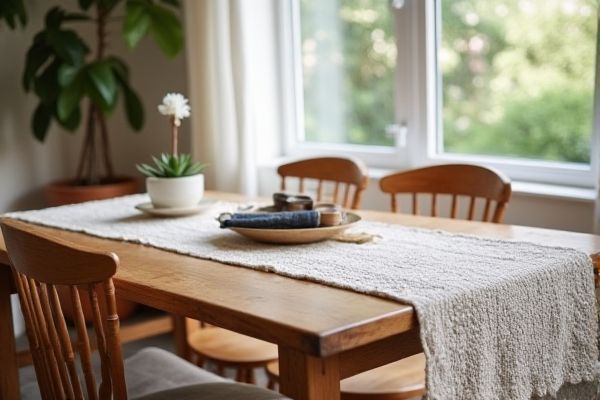
A runner is a narrow strip of fabric designed to lie down the center of a table, adding elegance without covering the entire surface, whereas a tablecloth provides full coverage, protecting the table and setting a uniform backdrop. Discover how to choose between a runner and a tablecloth to perfectly enhance your dining experience in the rest of this article.
Table of Comparison
| Feature | Runner | Tablecloth |
|---|---|---|
| Coverage | Narrow strip covering center of table | Full table coverage |
| Purpose | Decorative accent, highlights table length | Protects and decorates entire table surface |
| Usage | Common in formal or layered table settings | Used for everyday or formal dining |
| Size | Varies, typically 12-18 inches wide | Sized to fit full table dimensions |
| Style versatility | Layered over tablecloth or bare table | Standalone or base for runners/placemats |
| Material Options | Linens, cotton, silk, polyester blends | Cotton, polyester, vinyl, lace, blends |
| Cleaning | Easier due to smaller size | Requires washing entire surface area |
Runner vs Tablecloth: Key Differences
A runner is a narrow, decorative piece of fabric placed lengthwise along the center of a table, enhancing the table's aesthetic without covering the entire surface. In contrast, a tablecloth covers the whole table, providing full protection and a uniform backdrop for dining settings. The key difference lies in coverage and style, as runners offer a versatile, layered look while tablecloths serve a more traditional, comprehensive function.
Material Choices for Runners and Tablecloths
Runners typically feature materials like linen, cotton, polyester blends, and sometimes silk, chosen for their durability and decorative appeal. Tablecloths often use heavier fabrics such as damask, velvet, or quilted cotton to provide full surface coverage and protection. Both options can include stain-resistant and wrinkle-free treatments to enhance functionality and maintenance.
Aesthetic Impact on Table Settings
A runner enhances the aesthetic impact of table settings by adding a narrow, focused stripe of color or texture that guides the eye along the length of the table, creating a sleek and elegant look. In contrast, a tablecloth covers the entire table surface, offering a uniform backdrop that can either highlight or mute other decorative elements depending on its pattern and material. Your choice between a runner and a tablecloth significantly influences the overall ambiance, balancing between minimalist sophistication and full table coverage.
Functional Benefits of Runners and Tablecloths
Runners provide a streamlined cover that protects the center of your table from spills and scratches while adding decorative flair without covering the whole surface. Tablecloths offer full table coverage, safeguarding against stains, heat damage, and wear while setting a cohesive look for formal or casual dining. Choosing between a runner and tablecloth depends on your need for surface protection combined with aesthetic preferences.
Best Occasions for Using Each
A table runner is ideal for festive dinners and casual gatherings, adding a decorative touch without covering the entire table surface, allowing Your table's natural beauty to show through. Tablecloths work best for formal events, weddings, and holiday feasts, providing full coverage that protects the table while creating an elegant, unified look. Choosing between a runner and tablecloth depends on the level of sophistication and protection needed for the occasion.
Cleaning and Maintenance Comparison
Runners typically require less frequent cleaning than tablecloths due to their smaller size and placement, making maintenance more manageable. Tablecloths often need thorough washing after every use, especially for full-table coverage, which can involve more fabric and weight. You can extend the lifespan of both by following care instructions, such as using gentle detergents and avoiding harsh wringing or bleach.
Table Size and Coverage Considerations
For larger tables, a tablecloth offers complete surface coverage, protecting the entire tabletop and creating a unified look. A runner provides a decorative accent suitable for narrow or standard-sized tables, highlighting the center while leaving edges exposed. Your choice depends on whether you prefer full protection and coverage or a stylish, partial enhancement that complements the table size.
Cost Comparison: Runners vs Tablecloths
Table runners typically cost less than full tablecloths due to their smaller size and reduced fabric usage, making them a budget-friendly option for events and everyday dining. Tablecloth prices vary widely based on material, size, and design complexity, often exceeding runner costs especially for larger or specialty fabrics. Choosing a runner can provide an elegant look while minimizing expenses, particularly for long or narrow tables where full coverage is unnecessary.
Decorating Tips for Both Options
Choose a runner to add a pop of color and texture while showcasing the table's natural surface, ideal for layering with placemats or candles. Opt for a tablecloth to create a unified, elegant backdrop that conceals imperfections and sets a cohesive tone for formal dining. Mixing and matching patterns and fabrics enhances visual interest, balancing style and functionality for any occasion.
Which is Right for Your Event?
Choosing between a runner and a tablecloth depends on the event's style and functionality. Runners provide a minimalist, elegant touch by highlighting the table's natural surface, ideal for casual or contemporary settings. Tablecloths offer full coverage and protection, creating a cohesive, polished look perfect for formal dinners and celebrations.
 homyna.com
homyna.com